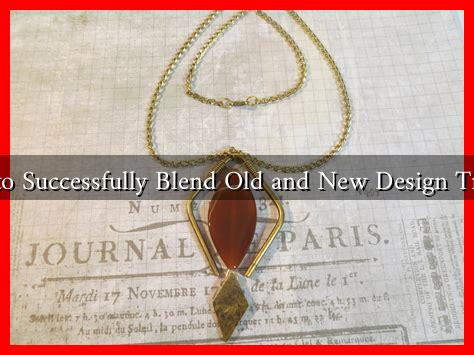-
Table of Contents
- How to Successfully Blend Old and New Design Trends
- The Importance of Blending Old and New
- Strategies for Blending Old and New Design Trends
- 1. Identify a Focal Point
- 2. Use Color as a Bridge
- 3. Mix Textures and Materials
- 4. Incorporate Vintage Accessories
- Case Studies: Successful Blends of Old and New
- Statistics on Design Trends
- Conclusion
How to Successfully Blend Old and New Design Trends
In the ever-evolving world of design, the challenge of merging old and new trends is both an art and a science. As designers and homeowners seek to create spaces that reflect their unique tastes while also paying homage to the past, understanding how to blend these elements becomes crucial. This article explores effective strategies for harmonizing vintage aesthetics with contemporary styles, providing insights, examples, and practical tips.
The Importance of Blending Old and New
Blending old and new design trends can create a rich, layered aesthetic that tells a story. This approach not only enhances visual appeal but also fosters a sense of nostalgia and comfort. Here are some reasons why this blend is significant:
- Timelessness: Combining classic elements with modern designs can create a timeless look that remains relevant across generations.
- Personalization: A mix of styles allows for greater personalization, enabling individuals to express their unique identities.
- Functionality: Modern designs often prioritize functionality, which can enhance the usability of vintage pieces.
Strategies for Blending Old and New Design Trends
Successfully merging old and new design trends requires a thoughtful approach. Here are some strategies to consider:
1. Identify a Focal Point
Choose a central piece that embodies the blend of styles. This could be a vintage chandelier in a minimalist room or a modern sofa paired with antique side tables. The focal point will guide the overall aesthetic and help unify the design.
2. Use Color as a Bridge
Color can serve as a powerful tool in blending styles. Consider the following:
- Neutral Palettes: Use neutral colors to create a cohesive backdrop that allows both old and new elements to shine.
- Accent Colors: Introduce accent colors that resonate with both styles, creating a visual connection.
3. Mix Textures and Materials
Combining different textures and materials can add depth to your design. For instance:
- Wood and Metal: Pair rustic wooden furniture with sleek metal accents for a balanced look.
- Soft Fabrics and Hard Surfaces: Use plush textiles alongside hard surfaces like glass or stone to create contrast.
4. Incorporate Vintage Accessories
Accessories are an excellent way to introduce vintage elements without overwhelming the space. Consider:
- Artwork: Hang vintage artwork or photographs to add character.
- Decorative Items: Use antique vases, books, or collectibles as decorative accents on modern shelves.
Case Studies: Successful Blends of Old and New
Several designers and homeowners have successfully blended old and new trends, serving as inspiration for others:
- The High Line Hotel, New York: This hotel features a mix of historic architecture with modern furnishings, creating a unique guest experience.
- Restoration Hardware’s Gallery: Their showrooms often showcase vintage pieces alongside contemporary designs, illustrating how to create a cohesive aesthetic.
Statistics on Design Trends
According to a survey by the American Institute of Architects, 60% of homeowners prefer a mix of traditional and modern styles in their homes. This statistic highlights the growing trend of blending old and new, emphasizing the importance of creating spaces that resonate with personal history while embracing contemporary aesthetics.
Conclusion
Successfully blending old and new design trends is an exciting challenge that can lead to stunning results. By identifying focal points, using color strategically, mixing textures, and incorporating vintage accessories, anyone can create a harmonious space that reflects both personal style and historical significance. As the design landscape continues to evolve, embracing this blend will not only enhance aesthetic appeal but also foster a deeper connection to the spaces we inhabit.
For more insights on design trends, visit Architectural Digest.


